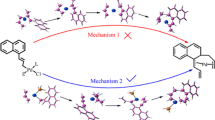Abstract
The formation of products of oxidative and reductive allylation of norbornadiene by allyl formate (AF) in the presence of Pd0 triphenylphosphine complexes was modeled by the PBE/L11 method in terms of the density functional theory. According to calculations of all most probable routes to the norbornadiene allylation products, the highest energy barriers correspond to the transition state of formation of the first C-C bond. Two complexes, Pd(AF)(PPh3)2 and Pd(AF)(PPh3), can be treated as catalytically active ones. The PPh3 ligands cause a 7.6–8.2 kcal mol−1 decrease in the activation barriers to the formation of the second C-C bond necessary to generate the products of oxidative allylation of norbornadiene. The formation of 5-methylene-6-vinylbicyclo[2.2.1]-hept-2-ene proceeds via opening of the cyclobutane ring.
Similar content being viewed by others
References
M. Catellani, G. Chiusoli, E. Dradi, G. Salerno, J. Organomet. Chem., 1979, 177, 29; DOI: https://doi.org/10.1016/S0022-328X(00)94094-4.
U. M. Dzhemilev, R. I. Khusnutdinov, G. A. Tolstikov, Russ. Chem. Rev., 1987, 56, 36; DOI: https://doi.org/10.1070/RC1987v056n01ABEH003255.
U. M. Dzhemilev, R. I. Khusnutdinov, D. K. Galeev, O. M. Nefedov, G. A. Tolstikov, Bull. Acad. Sci. USSR, Div. Chem. Sci., 1987, 36, 122; DOI: https://doi.org/10.1007/BF00953861.
I. P. Stolyarov, A. E. Gekhman, I. I. Moiseev, A. Yu. Kolesnikov, E. M. Evstigneeva, V. R. Flid, Russ. Chem. Bull., 2007, 56, 320; DOI: https://doi.org/10.1007/s11172-007-0052-x.
R. S. Shamsiev, V. R. Flid, Russ. Chem. Bull., 2020, 69, 653; DOI: https://doi.org/10.1007/s11172-020-2813-8.
E. M. Evstigneeva, V. R. Flid, Russ. Chem. Bull., 2008, 57, 837; DOI: https://doi.org/10.1007/s11172-008-0121-9.
S. A. Durakov, R. S. Shamsiev, V. R. Flid, A. E. Gekhman, Russ. Chem. Bull., 2018, 67, 2234; DOI: https://doi.org/10.1007/s11172-018-2361-7.
S. A. Durakov, R. S. Shamsiev, V. R. Flid, A. E. Gekhman, Kinet. Catal. (Engl. Transl.), 2019, 60, 245; DOI: https://doi.org/10.1134/S0023158419030042.
S. A. Durakov, R. S. Shamsiev, V. R. Flid, Russ. Chem. Bull., 2021, 70, 1290; DOI: https://doi.org/10.1007/s11172-021-3213-4.
S. A. Durakov, P. V. Melnikov, E. M. Martsinkevich, A. A. Smirnova, R. S. Shamsiev, V. R. Flid, Russ. Chem. Bull., 2021, 70, 113; DOI: https://doi.org/10.1007/s11172-021-3064-z.
K. N. Gavrilov, I. V. Chuchelkin, V. K. Gavrilov, S. V. Zheglov, I. D. Firsin, V. M. Trunina, A. V. Maximychev, A. M. Perepukhov, Russ. Chem. Bull., 2021, 70, 336; DOI: https://doi.org/10.1007/s11172-021-3090-x.
R. S. Shamsiev, K. T. Egiazaryan, V. R. Flid, Russ. Chem. Bull., 2021, 70, 316; DOI: https://doi.org/10.1007/s11172-021-3087-5.
D. N. Laikov, Chem. Phys. Lett., 1997, 281, 151; DOI: https://doi.org/10.1016/S0009-2614(97)01206-2.
D. N. Laikov, Yu. A. Ustynyuk, Russ. Chem. Bull., 2005, 54, 820; DOI: https://doi.org/10.1007/s11172-005-0329-x.
J. P. Perdew, K. Burke, M. Ernzerhof, Phys. Rev. Lett., 1996, 77, 3865; DOI: https://doi.org/10.1103/PhysRevLett.77.3865.
D. N. Laikov, Chem. Phys. Lett., 2005, 416, 116; DOI: https://doi.org/10.1016/j.cplett.2005.09.046.
R. S. Shamsiev, V. R. Flid, Russ. Chem. Bull., 2013, 62, 2301; DOI: https://doi.org/10.1007/s11172-013-0333-5.
N. S. Rukk, R. S. Shamsiev, D. V. Albov, S. N. Mudretsova, Fine Chem. Technol., 2021, 16, No. 2, 113; DOI: https://doi.org/10.32362/2410-6593-2021-16-2-113-124.
K. T. Egiazaryan, R. S. Shamsiev, V. R. Flid, Fine Chem. Technol., 2019, 14, No. 6, 56; DOI: https://doi.org/10.32362/2410-6593-2019-14-6-56-65.
M. Murakami, N. Ishida, J. Am. Chem. Soc., 2016, 138, 13759; DOI: https://doi.org/10.1021/jacs.6b01656.
Author information
Authors and Affiliations
Corresponding author
Additional information
Published in Russian in Izvestiya Akademii Nauk. Seriya Khimicheskaya, No. 5, pp. 905–914, May, 2022.
This work was financially supported by the MIREA — Russian Technological University within the framework of a “University” grant for young scientists.
No human or animal subjects were used in this research.
The authors declare no competing interests.
Rights and permissions
About this article
Cite this article
Shamsiev, R.S., Egiazaryan, K.T. & Flid, V.R. Allylation of norbornadiene in the presence of Pd0 phosphine complexes: a DFT modeling. Russ Chem Bull 71, 905–914 (2022). https://doi.org/10.1007/s11172-022-3489-z
Received:
Revised:
Accepted:
Published:
Issue Date:
DOI: https://doi.org/10.1007/s11172-022-3489-z



